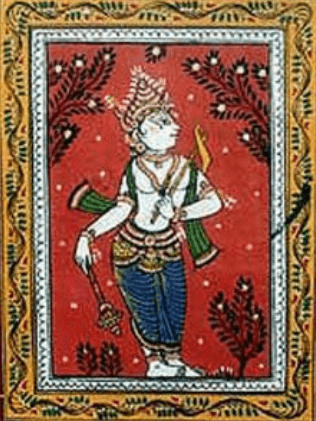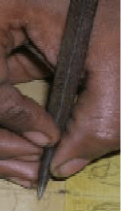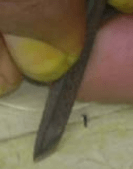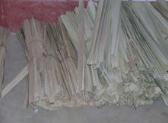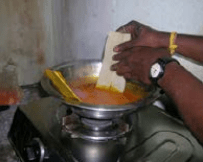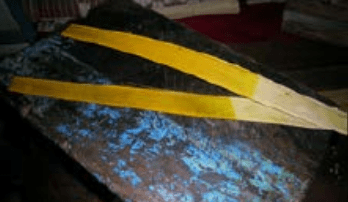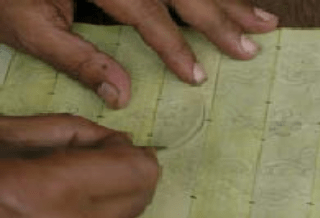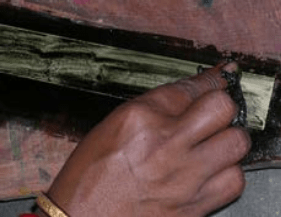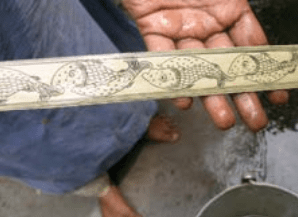REGION / LOCATION
The village of Raghurajpur is where many chitrakars live in an area dedicated to them called the Chitrakar Sahe. This lies inPuri district, approximately 52 kilometers from Bhubaneshwar.
CRAFT TRADITION
Hundreds of years back before the paper was invented people used to write and draw on palm leaves. Ancient manuscripts like the Vedas and Upanishadas, epics such as the Ramayana and the Mahabharata, were originally written on palm leaves. Palm leaf etchings are intricate linear drawings which present delicate and beautiful mythological figures of god, goddesses, animals, fish, and flowers. This ancient craft of palm leaf illustration is still made using the age old system with great care and minute detail.
RAW MATERIALS
Palm Leaves
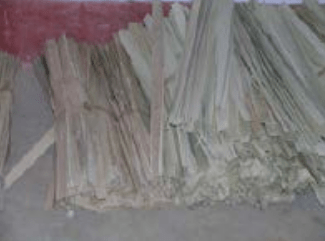
They form the base for each painting and are locally available. Palm leaves are sun dried before use.
Cotton Cloth
Cotton cloth is sometimes used as a base under the palm leaf painting to give it added strength. Additionally, it is also used as a piping around the painting.
TOOLS
Paper Cutter
This is used for cutting the palm leaves into desired sizes for painting.
String and Needle
These are used to stitch the dried palm leaves together. Normally, a black string is used.
Lekhani
It is an iron stylus or pen which is used for en graving on the palm leaf.
Iron Cutter
This is used to cut out the etched portion in the painting according to design.
COLOURS
Palm leaf etchings are mainly coloured black. It is formed from lamp black or lamp soot. A burning lamp is placed inside an empty tin, till a considerable amount of soot collects on it’s under side. The soot is then mixed with gum and water for use. The oil used in the lamp is acquired from polang tree seeds which are locally available. Any other colours, if applied, on the painting are same as the ones used in Patachitra.
PROCESS
The process of Palm leaf paintings is started by collecting palm leaves and sorting them according to similarity in appearance, colour and texture.
The leaves are dried and a mixture of haldi and neem is applied on them. This is done to make them durable, long lasting and to prevent them from decaying.
For the processing of 100 leaves, 200 grams of haldiand few neem leaves are soaked in approximately 2 liters of water. Then the leaves are dipped in the solution. The number of times the palm leaves are dipped in this solution depends on the colour tone required for them.
The leaves are then naturally dried in sunlight. Processed leaves are stitched together with a string to form a flat surface. Then the theme or picture to be painted is etched on the upper layer of the leaves with the fine metal pen called ‘lekhani’.
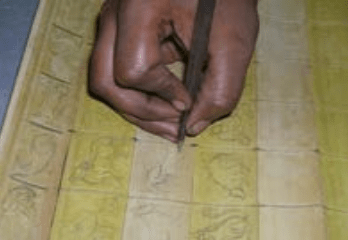
Some paintings have a circular theme, in which the circles are cut after engraving with an iron cutter and the story runs through the circles.
Five colours-black, white, red, brown, and yellow are used but black gives a more natural look to the painting. Natural black colour (eye salve) is applied on leaves. It is necessary to remove the excess paint quickly, so the leaves are then washed. If any other colour has to be used, it has to be applied with a brush.
The paintings are folded and tied with a coloured or decorative string. These are either supported by a cotton cloth at the back or are left uncovered. This is done to give added strength to the paintings.
MARKET
Palm leaf etchings or Talapatachitras are intricate linear drawings which present delicate and beautiful mythological figures, animals, fish, flowers etc. These are rare artistic pictures which can be used as wall hangings and make unique gifts.
With changes in customer tastes and economic conditions, craftsmen have started developing utility products. The new range of products in the market includes small boxes, visiting card holders, mats etc. As this art is handmade the designs and sizes can be made to suit the needs of individual purchasers.
CHANGES OVER THE YEARS
Technology
This ancient craft is still made using an age old system and technology with great care and in minute detail.
Design
The designs for the paintings remain the same and are based on mythological themes. Since there is product diversification from paintings to utility items, the designs or motifs applied are simple.
Market
With rising demand in the market for a different variety of products, Palm leaf paintings are being used for utility items such as boxes, mats, table runners, pen stands and visiting card holders
PRODUCTS AND THEIR USES

Chess board, Visiting card holders, Ganjifa cards
Boxes:
Different sizes and shapes of boxes with etching on the lid and body are new in the market
Sarat Chandra Swain is a master craftsman of this well known craft in Orissa. He is a farmer by caste but is titled a Maharana for his skill. He has been working on Patachitra and Palm leaf paintings since1974, from the age of 13. Based in Raghurajpur- a village known for its craft traditions in District Puri, Orissa, he has dedicated his entire life towards the craft.
The entire village of Raghurajpur is engaged in crafts, the most popular of these being Patachitra and Palm leaf painting. An organization called “PARAMPARA” works for marketing of the products made in the village and provides facilities such as a work space and raw materials. According to the master craftsman, initially, they had problems regarding raw materials but now they have found people and places that provide a regular supply of raw materials to the entire village. The craftsmen here are very happy with their socio-economic status. According to them they are paid according to their inputs.

